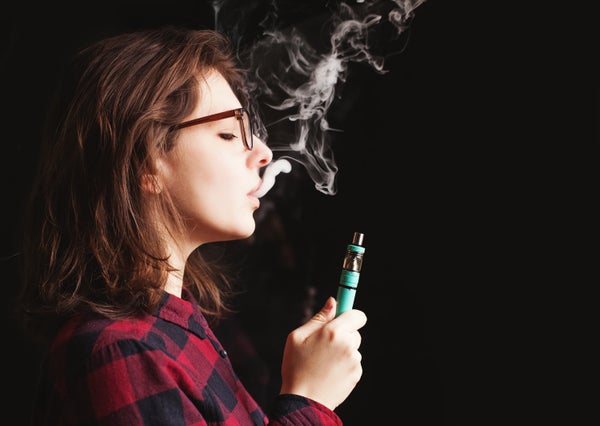U.S. teens are turning to vaping in record numbers, with rates climbing dramatically since 2017. The National Institute on Drug Abuse (NIDA) has released its 2019 Monitoring the Future survey of eighth, 10th and 12th graders across the country, and the results indicate an alarming increase across all three age groups.
When asked whether they had vaped in the last month, high school seniors reported about doubling their rates in the span of a year, going from 11 percent in 2017 to 20.9 percent in 2018. Moreover, 27.8 percent of teens reported “any vaping” in 2017, rising to 37.3 percent in 2018. Perhaps most disturbing, one in 10 eighth-graders reported having vaped within the last year.
NIDA Director Nora Volkow looks to past successes with anti-tobacco campaigns as a model for how to tackle the challenge of runaway vaping rates among U.S. adolescents. She also offers a surprising but speculative explanation for the bright spot in the survey results: These same children are reporting record-low alcohol use, the lowest opioid use of any age group and low use of marijuana, tobacco and other drugs.
On supporting science journalism
If you're enjoying this article, consider supporting our award-winning journalism by subscribing. By purchasing a subscription you are helping to ensure the future of impactful stories about the discoveries and ideas shaping our world today.
[An edited transcript of the interview follows.]
How do we get across the dangers of vaping to an age group notorious for an underdeveloped sense of long-term consequences?
I think that’s part of the challenge: How do you communicate the message of potential negative effects to a teenager in a way that’s salient to them? Let’s learn from past experience on issues that have worked, then replicate them and adapt them to new conditions.
Vaping has become very glamorized for them because these are quite cool-looking devices on the one hand, and other kids are using it, so it has become a fashionable item. But you can turn something fashionable into something that is rejected. Smoking cigarettes among teenagers was very glamorous at one point in this country, and now there is a very high rate of disapproval of smoking cigarettes. You have to find a way to communicate something to kids that are not going to be moved by arguments that would convince an adult.
You can do prevention messaging. All of these very smart people sit around tables to determine how to make kids buy these drugs. One of the elements that they use is to actually recruit teenagers themselves to say what works for them or not. For these (prevention) campaigns, it is extremely relevant to include those who are affected by it, taking into consideration that this group is quite diverse.
Speaking of underdeveloped, what are the developmental risks of vaping for teens?
Because the adolescent brain is developing rapidly, drugs like nicotine or marijuana modify the developmental trajectories. They interfere with a very well-orchestrated process that is very much regulated by evolution to maximize getting a brain that is optimal and basically constructed to respond to our environment. When you take drugs, it will be constructed to respond to drugs. You may interfere with the normal development of the brain in ways that jeopardize cognitive and emotional processing and put yourself at much greater risk of addiction. Research shows that nicotine acts as a priming drug that makes your brain more sensitive to other drugs—the concept of a gateway drug.
Some studies claim that the nicotine content of some of these products rivals the amount in a pack of cigarettes. Are children at increased addiction risk from this factor alone?
I think that they are going to become very rapidly addicted because electronic devices are optimal delivery systems for drugs. They deliver drugs straight to the lungs, these organs composed of a very extensive network of blood vessels. This delivery of nicotine will immediately get it into the blood system at high concentrations and rapidly to the brain. The speed the drug gets to the brain makes it more addictive and rewarding. Nicotine is harder to get out of smoking cigarettes because of the coughing response to smoking.
What are other health risks associated with vaping beyond addiction? Are there immediate or short-term health consequences for these children?
I think that we are going to start to see it. There are a couple of reports about these inflammatory responses that can be very serious and that are associated with vaping. I predict that we are going to start see more. The more widespread it is, the more the likelihood that we will rapidly start to see the consequences. Like anything else, there are some people who are able to smoke until they are 100 years of age and no problem and yet there are others who rapidly become sick from it. Some will be more vulnerable than others.
What are some points of access where this runaway increase can be stopped?
We know that policies for taxes on tobacco and alcohol significantly have reduced consumption among teenagers. The two major tools that make a big difference are policy and enforcement, rolling taxes into these vaping devices and making them much more expensive. But if you implement the regulation, you have to enforce it—and have strong educational campaigns with elements that are salient to teenagers.
Some of these other measures are declining. What happened that made teens stop using these substances even as they were increasing their vaping?
One hypothesis is that teenagers have changed their communication over to social media. Drug-taking is a group behavior and driven a lot by peer pressure. If you are not with other teenagers who are taking drugs, you will be less likely to be exposed to drugs. Social interaction has changed in such a way that the decreased face-to-face time may have decreased exposure to drugs.
